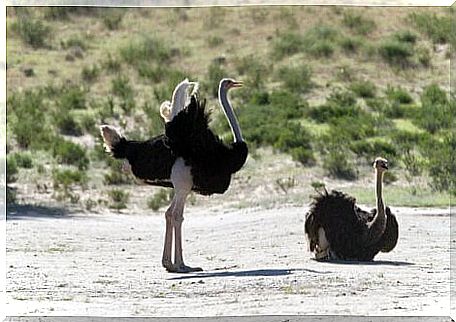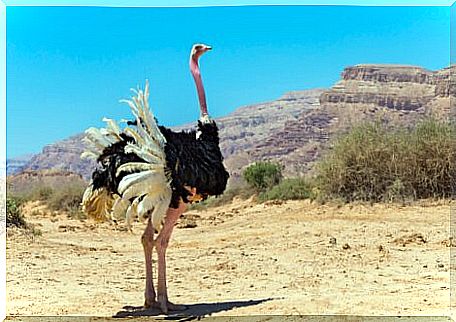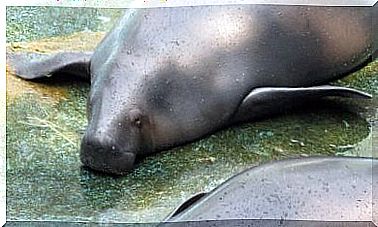Does The Ostrich Bury Its Head In The Ground? Truth Or Myth

Animal behavior is a complex field of study in which many mysteries remain unsolved. However, the question of whether the ostrich buries its head when it is afraid is no longer one of them.
This idea is definitely a myth, albeit a persistent one. This behavior is not only not observed in nature, it also has no biological meaning. If ostriches followed this strategy, predators would not miss the opportunity to devour them.
We invite you to stay with us if you want to know more about this myth and the real behavior that ostriches show against predators.
A myth that comes from antiquity
There is no doubt that this supposed behavior is a myth. However, it is a very old belief as some sources indicate that it can be traced back to Roman times.
Specifically, its origin can be found in the writings of Pliny the Elder, an important Roman writer and naturalist whose works have had great weight in history. Pliny was responsible for writing one of the first encyclopedias, called Naturalis Historia .
In this magnificent work, Plínio claims that ostriches bury their heads in the ground and, in doing so, believe that their entire body is hidden. Although this is not true, the myth has remained relevant over time, as it was integrated into language and human beings reproduced it in various ways.

Curiosities about ostriches that may have originated this myth
These animals exhibit certain behaviors that, for some observers, can be confusing. In fact, ostriches don’t bury their heads, but they do have some very peculiar behavioral adaptations.
Ostriches build their nests by digging a shallow hole in the ground. Once the eggs are laid, they are often repositioned to ensure they receive the right conditions. The point is that ostriches move them with their head, so it might look like they’re hiding that part of their body.
On the other hand, these animals look for food on the ground, but keep upright. The head of ostrich is very small, so during feeding it can also look like they are burying it.
Also, these birds ingest small stones from the ground. These mineral elements, called gastrolytes, help crush food in the digestive system since these animals cannot chew. If this information is unknown, it’s easy to think the animal is just burying its head.
Why doesn’t the ostrich bury its head when it feels threatened?
It is clear that no ostrich bury its head when it is afraid or to flee from predators. If you look closely at these animals in the wild, you won’t see this behavior.
There are some physiological and evolutionary explanations why this strategy does not occur. If the ostriches did bury their heads, they would have difficulty breathing. In addition, they also couldn’t see predators, which is often very useful to avoid them.
In general, this behavior is justified by the idea that ostriches are so unintelligent that they don’t notice these problems. While it’s true that your brain is very small compared to your body, intelligence doesn’t play a very important role in these aspects.
Instead, what’s really vital is natural selection. This evolutionary mechanism indicates that organisms with characteristics better suited to their environment will be more likely to survive than the rest of the population. Therefore, they will have more offspring and these characteristics will become more prevalent in the population.
Ostriches that exhibited the behavior of burying their heads would likely be eaten by predators. Therefore, they would have no descendants and that strategy would quickly disappear.
Real Ostrich vs Predator Strategies
As we’ve already said, the ostrich doesn’t bury its head in this situation. Instead, he has other very effective strategies for defending himself and avoiding predation.
First of all, ostriches are incredibly fast. They cannot fly, but reach speeds of up to 70 kilometers per hour. Therefore, when they spot a predator, one of the birds’ most effective strategies is to flee.
The powerful legs of the ostrich, together with their pointed claws and their enormous size, offer these birds a second alternative defense. Faced with some threats, ostriches may choose to get up and attack with very strong kicks.
When none of these defenses are viable, these birds are also able to hide in vegetation. To do this, they lie completely on the floor, not just hiding their heads.
Lastly, these animals help each other. When in groups, ostriches take turns keeping an eye on their surroundings and feeding. This makes it easier for the group to detect threats.

As proven, this perception about ostriches is nothing more than a very popular myth. While there is nothing wrong with using it as a metaphor, it is necessary to take into account the actual behaviors of animals and not reduce them to preconceived ideas.









